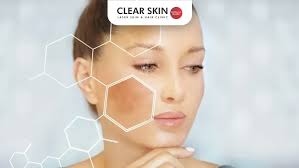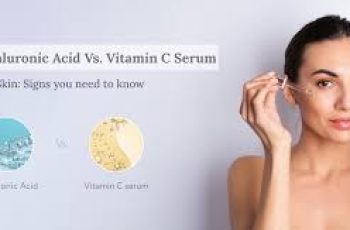How To Get Rid of Melasma
In my dermatology clinic in Miami Florida, I have treated patients with the frustratingly persistent dark spots from melasma every workday for the last 20 years. Melasma is common in women ages 40 and under, is very hard to get rid of, and tends to be worse in hot, sunny climates like Miami.
What is Melasma?
Melasma is caused by clumps of excess melanin pigment in the skin. These dark brown or greyish spots most commonly occur on the forehead, upper lip, mustache area, and cheeks but the dark spots can occur on any parts of the face.
How to Get Rid of Melasma Forever?
It is not easy- but it is possible to get rid of melasma permanently. This involves a commitment on your part to change your lifestyle habits and consistently alternate between a treatment skincare routine and a maintenance skin care routine. I recommend that you read this entire blog before spending a lot of money on a skincare routine. Educating yourself on how to prevent worsening of melasma is the best way to get rid of melasma.
Treating melasma involves understanding the causes of melasma and making lifestyle changes that help prevent this persistent skin condition from coming back. Melasma loves to come back and it tends to recur on the exact same part of your face every time it recurs.
Skincare Routine to Clear Melasma
The best skincare routine to treat melasma really depends upon your Baumann Skin Type. This is because your cleanser and moisturizers will dramatically affect how well your skin lightening skincare routine works. In fact, if skin care products for melasma did not work for you in the past- it is probably because you did not combine products correctly in your skincare routine. The order of the steps in the skincare routine matters! In fact- the entire point of Skin Type Solutions is to help you design a step-by-step skincare routine for melasma where you choose the products for each regimen step from a list of products our dermatologist have tested. You can choose which brand, what price point etc., and the best part is that you can be confident that you have the right products for your skin type and that you are using them in the correct order. All you have to do is take the skin type quiz.
Take the Quiz
Most of the time, melasma skincare routines take 12-16 weeks to clear melasma. One reason it takes so long to erase melasma is that it takes around 40 days for the old skin cells to desquamate off of the skin’s surface and get replaced with younger less pigmented cells. Plus- if you miss a day or one application of your skincare routine- your melanocytes make more melanin and – suddenly –you are back to the beginning and the clock restarts. So—- CONSISTENCY MATTERS!
What Causes Melasma?
Melasma occurs when the skin makes too much of the skin pigment melanin causing an uneven skin tone. The skin color of the melasma spots can be grey, brown or black depending upon the type of melanin and how deep the melanin is in the skin, and what your natural skin color is.
The reasons melasma occurs is not completely understood but we know that the following all play a role in causing and worsening melasma:
Sun and light exposure (Yes -your cell phone and computer screen can worsen melasma)
Heat (I had a patient who was a baker and an oven made her melasma worse)
Hormones (Estrogen in pregnancy, birth control and hormone replacement therapy)
Inflammation
Stress (The stress hormone cortisol can cause melasma)
Over exfoliation (This causes inflammation)
Best Natural Melasma Treatments
Avoid any of the melasma causes listed above. Sun avoidance is key!
Eat a diet with fruits and vegetables to increase the amount of antioxidants in your body.
Get 7 hours of sleep
Reduce stress (mediate, yoga etc.)
Supplements and Vitamins for melasma- click here to learn more
Avoid infrared saunas or other heat exposure
Don’t get laser or light treatments- they can make melasma worse
The chances are that these natural DIY and melasma home remedies will not be enough to erase stubborn melasma that won’t go away easily. If you have underlying skin inflammation, then the melanocytes continue making pigment and you cannot get rid of melasma until you turn the melanocytes off so that they stop producing melanin. So -what do you do?
How To Remove Melasma?
Should you get lasers and lights and other treatments for melasma?
My best advice is- don’t get treatments for melasma that can injure skin, cause inflammation, and ultimately make melasma worse. I know- you hear all the time about how good lasers are for melasma- but trust me- it’s not worth the risk. (It is possible that in colder climates with less sun exposure the experience doctors see treating melasma with lasers is different than mine). I often see patients who have had laser, light, microneedling, or radiofrequency with other doctors that improved the melasma for a few months, but the dark spots came back worse after 3-5 months. (It is possible that the ones who had successful treatments don’t come and see me because their melasma is cured.) The fact is that at least once a week I have someone in my office who had a laser treatment for melasma with another doctor and it made the melasma worse. So my advice is- do the slower safer approach—a good melasma skincare routine. Chemical peels to treat melasma are a safer option when performed by a well-trained aesthetician or medical provider. Even if you choose to do a medical procedure for melasma, you still need to combine it with a skincare routine.
What Skincare Products to Use to Get Rid of Melasma?
You will need to use skincare products with skin lightening ingredients twice a day. Do not miss any applications. You need to pair skin lightening products with the correct cleansers and moisturizers. The type of skin lightening product you choose, for example a cream or a serum, depends upon your Baumann Skin Type and if you are oily or dry. Which skin lightening ingredients to choose depends upon whether or not you have sensitive skin or aging skin. It is always best to choose products to treat melasma that are right for your Baumann Skin type.
Take the Quiz
Click on the image below to find skin care products to treat melasma.
Most important tips for getting rid of melasma:
Know Your Baumann Skin Type
Follow our melasma skin care routine advice customized for your Baumann Skin Type
Use the products in the correct skincare routine order
Use them consistently twice a day as directed.
Change your lifestyle habits
Avoid sun and heat
Wear SPF every day even when indoors (because of light exposure)
Change your routine after 3-4 months to a Melasma Maintenance Routine
Get started NOW!
DQH Knowledge drop: In your 20s, your skin cell turnover decreases. (Cell turnover is a key component in keeping your skin youthful.) You know what else slows down? Your collagen production. Starting in your 20s, collagen decreases by about 1 percent per year. Should you want to prevent fine lines and wrinkles, start by eliminating behaviors that contribute to premature aging. “If it’s bad for you, it’s bad for your skin,” says dermatologist Michel Somenek.
“Cigarette smoking reduces blood flow to the skin and causes premature wrinkling and a dull skin texture. Making the repeated pursed motion to inhale can also cause smoker’s lines. Alcohol and recreational drugs are toxins for the skin that damage its cellular structure and DNA,” Somenek tells us. “The faster you eliminate vices while you are young, the better chance your skin and body have to recuperate.” Also, adopting an anti-aging routine in your 20s is key. After all, the best offense is a good defense. We spoke to Somenek and experts Joshua Ross and Audrey Kunin to find out more.
Keep reading for the best anti-aging products for your 20s, according to skincare professionals.
Sunscreen
“We all know that the sun is the number one cause of skin aging and starting the prevention in your 20s is very important,” Ross says. “The majority of your sun damage won’t start to appear until you’re in your 30s, so don’t wait until you see it surface or you’ll be behind the curve. Stay ahead of it with a good-quality zinc-based sunscreen worn daily.”
Farmacy Green Defense Daily Mineral Sunscreen
An invisible sunscreen with SPF 30, plus botanical extracts meant to protect skin with tons of antioxidants. Bonus: It’s clean and fine to use under makeup.
Bareminerals Complexion Rescue™ Tinted Moisturizer Broad Spectrum SPF 30
Although we recommend you use your SPF and moisturizer separately, we also understand moments when you don’t have time or energy for that extra step. For those times, this bareMinerals moisturizer is a great thing to have on hand.
Vitamin C Serum
“A great introduction to anti-aging is to start with a vitamin C serum in your morning skincare routine,” Ross says. “It’s a powerful antioxidant that will neutralize free radicals and brighten the skin.” He adds that it’s a great way to counteract the effects of the sun’s harmful rays, which, as previously mentioned, are among the biggest causes of premature aging.
Drunk Elephant C-Firma™ Vitamin C Day Serum
The Drunk Elephant C-Firma is a lightweight serum that promises to give skin a glow by combining the brightening powers of vitamin C with ferulic acid, l-ascorbic acid, and vitamin E. The included sodium hyaluronate is meant to replace hydration loss, so you shouldn’t have to deal with any irritation.
Sunday Riley C.E.O. Rapid Flash Brightening Serum
This potent serum is jam-packed with vitamin C (15 percent, to be exact), which means it’s a potential superstar at both brightening skin and dousing it in antioxidants.
Peptides
Using peptides on your skin has many benefits, says Somenek. “The skin barrier is what defends the body against pollution, UV rays, bacteria, and toxins. It can be damaged by several everyday factors. Using topical peptides aids in building a stronger barrier,” he says. “Peptides comprise elastic fibers, which are a type of protein. These fibers help to make skin appear taut and firm. Peptides can also help repair damaged skin, relieve inflammation, and even out skin tone. Some peptides can kill acne-causing bacteria that is common in 20-somethings.”
Kunin agrees, saying, “Peptides are an excellent entry point for supporting collagen.” She recommends looking for face and eye treatments that contain these collagen-boosting powerhouses.
Charlotte Tilbury Magic Eye Rescue Cream
This Charlotte Tilbury super-emollient eye cream has a base of coconut oil and shea butter (read: it’s incredibly hydrating). Botanicals plus peptides are meant to help reduce dark circles and boost collagen, respectively.
This creamy moisturizer serves up potent collagen-boosting peptides and pycnogenol, and antioxidant-rich vitamin C. “Instead of sitting on top of the skin, peptides penetrate the outer layer so they go deep. The ‘signals’ they send tell the cells to produce elastin and collagen, which are needed for youthful-looking skin,” explains Somenek.
At-Home Peel Pads
Remember that skin cell turnover fiasco we talked about earlier? One way to help support it is by exfoliating. “Exfoliation is important to help keep skin fresh and luminous,” Kunin says. She recommends using at-home peel pads as an easy and effective way to exfoliate.
“The goal in your 20s is to fight the slowing pace of cell turnover. It is wise to use products that gently exfoliate, yet still remove oil and other impurities. Products that have Alpha Hydroxy Acids (AHA) or Beta Hydroxy Acids (BHA) are a good choice.”
According to Somenek, you should only exfoliate two to three times a week. “People of all ages are guilty of over-exfoliating and that can be too much of a good thing,” he says.
Dermadoctor Kakadu C Intensive Vitamin C Peel Pad
A few swipes of this Derma Doctor powerful peel pad promise to leave your skin glowing and smooth, thanks to the seven (yes, seven) types of chemical exfoliants, including AHA and BHA. It also contains vitamin C via Kakadu plum extract for added brightening and antioxidant protection.
KEY INGREDIENTS Kakadu plum extract is sourced from the Kakadu plum, a fruit grown in northern Australia. It contains vitamin C, which restores the skin’s natural barrier, increases collagen production, and soothes irritation.
Dr. Dennis Gross Skincare Alpha Beta® Universal Daily Peel Pads
These are the gold standard of peel pads, with a cult following and over 900 five-star reviews on Sephora. They’re easy to use and contain a blend of anti-aging exfoliating acids.
Emollient Night Cream
“In your 20s, you need to start upping the hydration in your skincare routine. You may have been cautious of over-moisturizing because of acne in your teens, but as you enter your 20s, your skin transitions and becomes drier,” Ross says. “I recommend an emollient night cream added into your evening skincare regimen.”
“Twenty-somethings need to make sure that they are not using creams that will clog their pores and cause excess oil production,” says Somenek. Opt for non-comedogenic products.
Cerave Skin Renewing Night Cream
One great choice is the CeraVe Skin Renewing Night Cream, which is a non-comedogenic night cream that leaves skin soft and glowy. It combines the moisturizing powers of ceramides and hyaluronic acid.
RoC Retinol Correxion Max Hydration Creme
“The best night cream ingredients contain retinol, benzoyl peroxide, and/or salicylic acid or hyaluronic acid. The goal is to moisturize, yet remove excess oil,” says Somenek. This Roc Retinol Correxion cream fits the bill as it contains both hyaluronic acid and retinol so it promises to moisturize while also being non-comedogenic.



